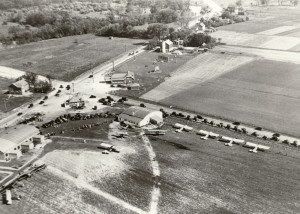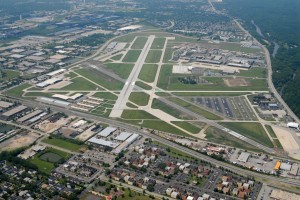By Pete Tobin

In the 1920s and ’30s, pilots navigating towards Chicago frequently followed Milwaukee Avenue or Palatine Road, and landed at that intersection. Palwaukee Municipal Airport’s name was derived from that intersection, shown in a 1929 photo.
The days of being “the little airport that could” are well in the past for Chicago’s Palwaukee Municipal Airport. The most noticeable change is a brand new name. As of October 17, PWK is officially Chicago Executive Airport.
“The primary reason for the name change was simply a branding issue,” stated Dennis Rouleau, airport manager. “Too many pilots didn’t realize that we’re Chicago’s main reliever airport, and didn’t know that we’re even in Chicago. Surprisingly enough, people thought we were in Wisconsin.”
Palwaukee Municipal Airport got its name in the days before sophisticated radio navigation. Pilots would follow either Palatine Road or Milwaukee Avenue until the roads intersected, and then land their planes there—hence, “Palwaukee.”
This isn’t a simple, little airport. Chicago Executive is a vibrant 24-hour, Delta-class international airport, handling 145,000 takeoffs and landings per year, pumping more than six million gallons of gas annually and providing a home base for 325 personal aircraft and 57 corporate jets, making it one of the top 10 busiest general aviation airports in the world. PWK is uniquely situated nine miles north of Chicago O’Hare International Airport and 18 miles northwest of downtown Chicago.
The original airport, which started in 1925 as Gauthier’s Flying Field, had a single dirt runway. A blimp hangar was added in 1933, and for a short time the field was an airship base. In 1953, George Priester acquired the airport property and added lights and the first of the paved runways, in order to accommodate DC-3s. The airport steadily grew. It had four paved runways by 1959, and its first instrument approach in 1961.
“Palwaukee was the Chicago base for the jet-setting “Rat Pack” in the 1950s and 1960s, according to Pam Kavanaugh, concierge for Atlantic Aviation.
“Sinatra, Martin and Sammy Davis Jr. all used this airport,” she said.
The airport’s international status rose in 2005, when PWK serviced a Canadian Bombardier Global 5000 that flew from there to Paris, France, in 7 hours, 15 minutes, beating the previous Chicago to Paris record by four minutes. That record still stands today.
Chicago Executive is presently home to three flight schools, where Rouleau says more than 10,000 students have earned their private rating since 1925. The primary runway is 5,000 feet long and 150 feet wide, and is able to handle jets up to 98,000 pounds, with three separate instrument approaches. The airport currently employs more than 300 people and annually injects more than $37.5 million into the local economy.
Today the airport is the primary reliever airport for O’Hare and Midway, and was named Illinois’ 2004 “Reliever Airport of the Year” by the Illinois Department of Transportation.
“Palwaukee had made great strides in the last decade that have transformed the airport from a private field to a well-known public facility,” said Timothy Martin, Illinois Department of Transportation secretary. “I believe Chicago Executive Airport will continue to grow and improve in the future.”
James Lang, Village of Wheeling economic development director, said that business people shouldn’t have to deal with the congestion and aggravation associated with O’Hare, when Chicago Executive can cater to their specific needs and welcomes the opportunity to showcase the airport for general aviation use.
“Chicago Executive is the most accessible airport for downtown Chicago,” said Richard Steinbrecher, a Young Eagles director. “The tower is extremely cooperative to all types of aircraft. They can handle the fastest business jets, but are still very supportive to the small aircraft community. They’ve been very active in their support of the Young Eagles program.”
Rouleau stated that someone had to step up to the plate and fill the void left by the destruction of Meigs Field in 2003.
“Our goal is to make Chicago easily accessible to the international business community,” he said. “That will not only advance aviation, but will also advance a city that we all love, whereby supporting the local communities of Wheeling and Prospect Heights.”
For more information, visit [http://www.palwaukee.org].













